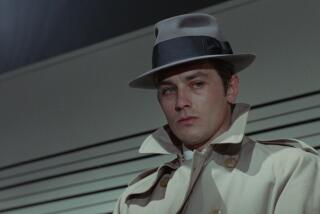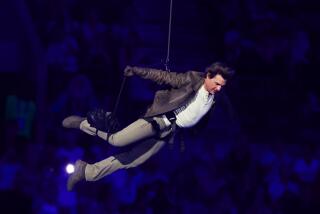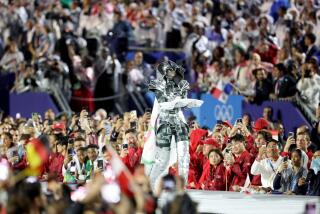For Once, It Looks Like an American in Paris : If Greg LeMond Keeps His Shirt On, He’ll Win the Tour de France Today
PARIS — Valery Giscard d’Estaing, the former French president, was in obvious distress. He was on television one night last week, pleading with Bernard Hinault, the man who carries France’s hopes on his handlebars.
“Couldn’t you do anything ?” Giscard d’Estaing asked Hinault, who shrugged and shook his head no.
There was apparently nothing Hinault could do to prevent Greg LeMond from leading 131 other cyclists on to the Champs Elysees this afternoon, when LeMond is expected to become the first American to win the 83-year-old Tour de France, the world’s most prestigious bicycle race.
It is the ultimate American-in-Paris experience, but LeMond, who is from Reno, Nev., should not feel out of place when he rides down the Champs Elysees, past two Burger Kings and movie advertisements for “Rambo” and “Raw Deal.”
During the time of Charles de Gaulle, the French had little tolerance for Americans, an attitude that has all but vanished, particularly among those born after World War II.
To his embarrassment, the French minister of culture discovered the change of heart a few years ago when he said that American culture, and he used that term loosely, was a form of U.S. imperialism that threatened France’s aesthetic purity. The minister obviously believed that aesthetics, like fine French wines, need time to ferment.
Many French people objected, telling the minister in no uncertain terms that there is room here for both the Mona Lisa and Alexis Carrington.
Greg LeMond, 25, could be on the verge of his own dynasty.
Even though he is an American in a sport that has been dominated by Europeans, Frenchmen in particular, LeMond is not unpopular in France.
Au contraire. He is respected to the point that he has been virtually adopted. After all, he rides for a dominant French team, La Vie Claire, speaks French impeccably and lives, when he is not training in Sacramento, a short distance from the French border in Kortrijk, Belgium.
Alain Danet, the president of The Racing Club, France’s largest sports organization, was asked last week for his opinion of an American leading the Tour de France.
“What do you mean, an American?” Danet said with a wink. “He is French !”
LeMond has felt like anything but a favorite son since last Sunday, when he became the first American ever to wear the yellow jersey, which goes to the overall leader after each leg of the 23-day, 2,543-mile race.
“An American in the yellow jersey, you don’t see that every day,” said Jacques Anquetil, a legendary cyclist of two decades ago.
He absorbs that for a moment.
“An American!”
LeMond has worn the yellow jersey each day since, which has made him a marked man for the thousands of taunting fans who line the course.
LeMond has been visibly shaken at times by the derisive crowd, but those who have observed the Tour de France for a number of years say the insults should not be interpreted as anti-American or even anti-LeMond.
“I think he has over-reacted,” said Pierre Briancon, the economic editor of the Paris newspaper Liberation who took time off work to follow the tour when it began outside Paris July 3.
“You have to understand that the French will side with whoever is No. 2. Even Hinault has felt this in other years, but because he has worn the yellow jersey so often, he understands. It is nothing personal.”
But that feeling might be even more intense this year since No. 2 is Hinault, France’s most revered athlete other than soccer superstar Michel Platini.
“LeMond is a clean-cut young American, and that appeals to the French,” Briancon said. “But he suffers because of Hinault’s popularity.”
Hinault, a tenacious Breton known as the Badger, is 31 and has announced that he will retire this year, perhaps after the world championships in Colorado Springs, Colo., next month, if he decides to compete.
French cycling fans thought it would be appropriate for Hinault to wear the yellow jersey onto the Champs Elysees one last time, giving him a record sixth victory in the Tour de France. Two others, Anquetil and Eddy Merckx, won five before they retired.
Hinault won his fifth last year, but he could not have done it without the aid of LeMond, his teammate on the La Vie Claire team.
What follows is a tale of two cyclists.
When Hinault took a nasty spill in the Pyrenees mountains more than midway through the 1985 race, he relinquished the lead and, it appeared, all hopes for victory.
LeMond, one of the strongest climbers in the sport, surged into the lead, riding far ahead of everyone except Irishman Steve Roche of the Carrerra Jeans team.
With the team championship to consider, and perhaps out of deference to Hinault, La Vie Claire’s coach, Paul Koecheli, ordered LeMond to slow the pace.
LeMond, who was certain that he could win, argued for himself, vigorously at times, but he finally relented, enabling Hinault to make up for lost time and eventually win.
LeMond finished a frustrated second, although he was able to rationalize it by telling himself that he would not have been invited to join La Vie Claire two years earlier if Hinault had not insisted. LeMond finished third in his first year with the team.
On the victory stand, Hinault embraced his teammate and promised that, in 1986, “I will sacrifice for you.”
LeMond was skeptical, particularly through the first half of this year’s race when it appeared that Hinault was going all out to win. LeMond was diplomatic in his comments to the French press, earning the nickname Gentleman Greg, but he complained bitterly to the American press, especially to CBS.
The La Vie Claire team, which includes five Frenchmen, two Americans, two Swiss and two Canadians, was divided into Hinault and LeMond camps.
“Who will eat whom?” asked the Paris sports newspaper L’Equipe.
But in a dramatic turn of events last Monday, after LeMond had taken the lead the previous day, Hinault delivered on his promise, leading the American on a long breakaway through the Alps. Hinault took the brunt of the wind, enabling LeMond to benefit from the drag and hold his lead.
As they neared the finish of that leg, LeMond pulled alongside Hinault and wrapped his arm around the Frenchman’s waist. Hinault raised LeMond’s hand, indicating they should cross the finish line together, but LeMond dropped back, allowing Hinault to win that day’s stage.
L’Equipe ran a front-page picture the next morning of LeMond and Hinault with their arms around each other.
“An Eagle With Two Heads,” the headline said.
Forty-eight hours later, after the only rest day since July 3, the eagle was of two minds.
“It’s Not Over,” the headline in L’Equipe read, quoting Hinault.
“I’ve already helped him,” Hinault told the newspaper. “We’ve already talked about it. It’s no longer a question of teamwork. We’re against each other. It’s up to him now to prove he’s capable of winning it all alone.”
LeMond bristled.
The tension was so thick it could have been cut with a guillotine.
LeMond’s mother was quoted in Liberation as suggesting that La Vie Claire might issue her son “a rotten bicycle so that he will lose this tour.”
The reporter noted that she was joking but added: “The atmosphere of suspicion has tarnished the triumph of the new American hero.”
Commenting on the stress that LeMond must feel, another reporter for the newspaper wrote: “Never before has a person in the yellow jersey had such a depressive face. He is at the end of his rope, psychologically.”
As for Hinault, he cannot lose.
The French press has declared that LeMond must share the victory with Hinault, even though it did not make the same demand of the Frenchman a year ago when LeMond made a greater sacrifice.
A columnist for L’Equipe wrote that LeMond will attain “a historical victory, led by our Hinault.”
A reporter for Liberation wrote that LeMond “knows that in France he will be remembered as a half-winner.”
The same reporter wrote that LeMond has not proved that he can win with panache, which is important to the French.
This melodrama has been played out before a nation of cycling fans, who are mesmerized by the Tour de France. Each afternoon, the race is televised, and highlights are shown each evening. For anyone who cannot get home in time to watch, there are television sets in various metro stations.
This has been a lost summer for the French, who spent last month in front of their TVs watching the World Cup soccer tournament from Mexico.
Since soccer is the most popular sport in France, the World Cup has more viewers here than any other event, but it is held only once every four years. The Tour de France inspires an annual madness. It is like a month-long World Series.
“An army from Mars could invade France, but if it happened during the Tour de France, nobody would notice,” former New York Times sports columnist Red Smith once wrote.
Now there is an invasion of a different sort. The race is dominated by foreigners. Of the top 10 in the overall standings through Friday, only three were Frenchmen. Besides LeMond, another American, Andrew Hampsten, also rides for La Vie Claire. He was in fourth place.
Some French cyclists have complained because it has become more difficult for them to find teams. But The Racing Club’s Danet said that the tour has benefited from the increased participation of foreigners.
“How can you claim to have the world’s greatest race unless the world is there?” he asked.
With the rest of the world’s cyclists also have come the rest of the world’s commercial sponsors, particularly the Americans and Japanese. Perrier, the primary sponsor of the tour for a number of years, lost out in 1984 to Coca-Cola.
For the first time ever, a U.S. company, 7-Eleven, had a team this year. Levi’s is considering entering a team next year.
“It’s a good thing for a sport that needed a breath of fresh air,” Briancon said. “Having two Americans among the first finishers will challenge the European riders to become even better.”
Briancon said that, despite whatever taunting LeMond has heard along the way, the American will be well received when he enters the Champs Elysees today.
“The reception will not be as great as it would have been for Hinault,” Briancon said. “The French are very chauvinistic, you know. But we also like to be part of history, and this is history.”
More to Read
Sign up for Essential California
The most important California stories and recommendations in your inbox every morning.
You may occasionally receive promotional content from the Los Angeles Times.










